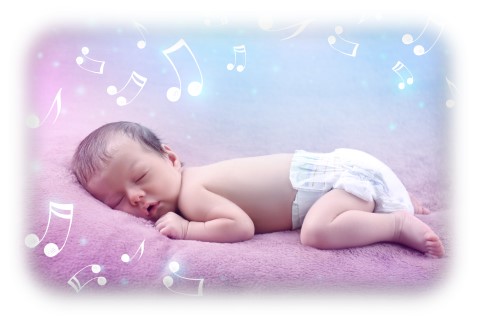MUSICAL
CONNECTIONS
Receptive
Birth to 3 months

December 1, 2023
The infant has limited physical abilities during the first few months, in contrast their brain is absorbing and sorting surrounding sounds. The baby is receptive to music sung to them and played. near them for short blocks of time. Creating and expanding their sound environment is an important goal. Here are the two main ways for making musical connections at this time.
1 Listening to music (recorded or an adult playing a musical instrument nearby)
Playing music during different parts of the day is a rewarding experience for the baby. Soft musical sounds heard at nap time or bedtime will assist the baby to relax and invites rest. Once a specific song has been identified that produces the desired results—continue to use it at the same time each day. Consistency will
help the baby learn to settle down and get comfortable with the routine of sleeping. This is the goal. However, unfortunately infants in the beginning have their own thoughts about sleep -- the when and how long of it all!
When playing slightly louder music for the willing listener, consider the location and volume of the device. It’s recommended that the sound level not reach over 60 decibels. (A quiet conversation is about 50 decibels.)
2 Listening to a singing parent
A parent singing to an infant or young baby in a loving manner is expressing language through sound. The listening baby brain is stimulated by the sounds being made through singing. The listening baby brain is stimulated by the sounds being made through singing. Lullabies help to calm a baby and can change a fussy infant into a calm one.
If the brain could talk, it would actually say – “More, give me more”! Singing excites
and ignites multiple areas located within the brain. Musical connections made
when singing are the gifts that just keep on giving!
SINGING:--a bit more A parent singing tunes to a child unaccompanied or accompanied by music is welcomed. The songs sung by the singer-parent may be:
- … familiar songs
- … new songs
- … “home-grown” originals
Familiar Songs (Nursery Rhymes, Lullabies etc.)
There are many nursery rhymes, lullabies and other songs that may be sung to an infant. The baby doesn’t understand what the words mean that’s true. It’s the sound of the parent’s voice singing to their listening baby that develops a musical connection. On the right are three popular public domain songs. (A song in public domain may be freely used for any purpose-no copyright.)
NOTE: Parent movement while singing to an infant is beneficial. While holding a baby in one’s arms sway gently back and forth during Music Time.
Mary Had A Little Lamb
- Mary had a little lamb,
- little lamb, little lamb.
- Mary had a little lamb,
- its fleece was white as snow.
And everywhere that Mary went,
Mary went, Mary went.
And everywhere that Mary went,
the lamb was sure to go.
It followed her to school one day,
school one day, school one day.
It followed her to school one day,
which was against the rules.
It made the children laugh and play,
laugh and play, laugh and play.
It made the children laugh and play,
to see a lamb in school.
Are You Sleeping?
Are you sleeping? Are you sleeping?
Brother John, Brother John?
Morning bells are ringing! Morning bells are ringing!
Ding, ding, dong. Ding, ding, dong.

Row, Row, Row, Your Boat
Row, row, row your boat
gently down the stream.
Merrily, merrily, merrily, merrily,
life is but a dream.

New Children’s Songs (new songs with original melodies and lyrics)
Talented musicians are creating new songs for children daily. Some lyrics help to teach about life’s necessities: eating, bathing, sleeping, etc. Other songs are designed to join the parent and baby together, sharing an emotional experience of love and caring. Musical selections may be viewed & heard on children’s TV programs, websites, YouTube or other social media platforms.
“Home-Grown” Originals (changing the words NOT the melody of a public domain song)
Don’t panic—this is an exciting way to be creative! Let the songwriter hidden within -- OUT! Creating a new melody is hard for many people. What seems to be easier is to start with an enjoyable known tune in public domain and change the lyrics to match its purpose. One good thing to take note of --if there’s a favorite song with a melody that one wishes to use at home, and it’s not in public domain yet—no worries. These are “home-grown” originals with a twist! Just remember that changing original lyrics to a non-public domain song may only be performed at home, unless one has permission and/or has paid a fee to the original songwriter.
When writing a “home-grown” original song remember there are no downsides, all songs will be accepted by the baby. The songs may be about what’s happening in the baby’s life or feelings of love held for the baby or informational (about family, animals etc.) or even silly giggly, wiggly nonsense tunes. One can mix in humming and la la la sounds, too. Just go for it! Here are three examples of “home-grown” originals that I’ve created for Music Time.
Are You Sleepy?
(Tune: Are Your Sleeping ?)
Are you sleepy? Are you sleepy?
My baby, My baby
Close your little eyes now.
Close your little eyes now.
One, two, three. One, two, three. earlyliteracylearning.com
Kiss, Kiss, Kiss My Baby
(tune: Row, Row, Row Your Boat)
Kiss, kiss, kiss your hand
Kiss your hand again.
Kiss, kiss, kiss your hand
Kiss your hand again!
Kiss, kiss, kiss your tummy
Kiss your tummy again.
Kiss, kiss, kiss your tummy
Kiss your tummy again!
Kiss, kiss, kiss your face
Kiss your face again.
Kiss, kiss, kiss your face
Kiss your face again!
(One could make all the verses having the word touch instead of kiss and add other body parts, too.)
earlyliteracylearning.com
These three melodies lend themselves to be used to make a variety of engaging new songs or “home-grown” originals. Stay tuned— MORE to come—in future posts!
Now It’s Time to Go To Sleep
(tune: Mary Had A Little Lamb)
Now it’s time to lay down,
lay down, lay down.
Now it’s time to lay down
sleepy head.
Now it’s time to go to sleep,
go to sleep, go to sleep.
Now it’s time to go to sleep
in your bed.
Close your eyes I love you,
I love you, I love you.
Close your eyes I love you,
here’s a kiss good-night!
(Sing in a soothing voice)
earlyliteracylearning.com

Making musical connections with your baby has so many benefits. It feeds the brain and the heart, --- a win, win for all!
Kylene
“The only thing better than singing is more singing.”
Resources & References
Decibel Pro: dB Sound Level Meter , Safe Decibel Levels for Babies, https:// decibelpro.app /blog/safe decibel levels for babies/
First 5 California, Humming, https://www.first5california.com/en-us/activities/humming-newborn-baby/
Harvard Gazette, (2020), Fre’re Jacques, are you sleeping?, Research shows lullabies in any language relax babies, https://www.researchgate.net/publication/258350904_Prenatal_Music_Exposure_Induces_Long-Term_Neural_Effects
Lensea, Miriam D., Shultzc Sarah , Astesano Cornie, Warren, Jones, (2022), Music of infant directed singing entrains infants’ social visual behavior, Psychological and Cognitive Sciences, PNAS, Psychological and Cognitive Sciences, PNAS, https:// www.pnas.org doi /10.1073/pnas.2116967119
Winkler,Istvan , Haden, Gabor P., Ladnig , Olivia, Sziller , Istvan , Honing, Henkjan , (2009), Newborn infants detect the beat in music, PubMed, National Library of Medicine, https://pubmed.ncbi.nlm.nih.gov/19171894/
Early Literacy Learning

